Last updated on
Explore these innovative mobile home skirting ideas because this component isn’t just for aesthetic appeal, it also plays a crucial role in protecting your home from adverse weather and pests.
I have created these unique designs for your inspiration. I hope you will enjoy them!
Enter the world of mobile home skirting where functionality marries aesthetics. Sure, the internet is brimming with popular skirting options. But hold tight, because in this article we are taking the less-beaten path. The aim here is to fuel your imagination with fresh, unique skirting ideas giving a new spin on your mobile home’s undercarriage.
Together, let’s navigate through the unknown territories of mobile home skirting, providing exciting alternatives. And don’t worry, if you’re interested in exploring the classics, you’ll find handy resources at the end of the article. Buckle up for a fascinating exploration of innovative mobile home skirting ideas, tailored to inspire.
Exploring Eco-Friendly Mobile Home Skirting Options
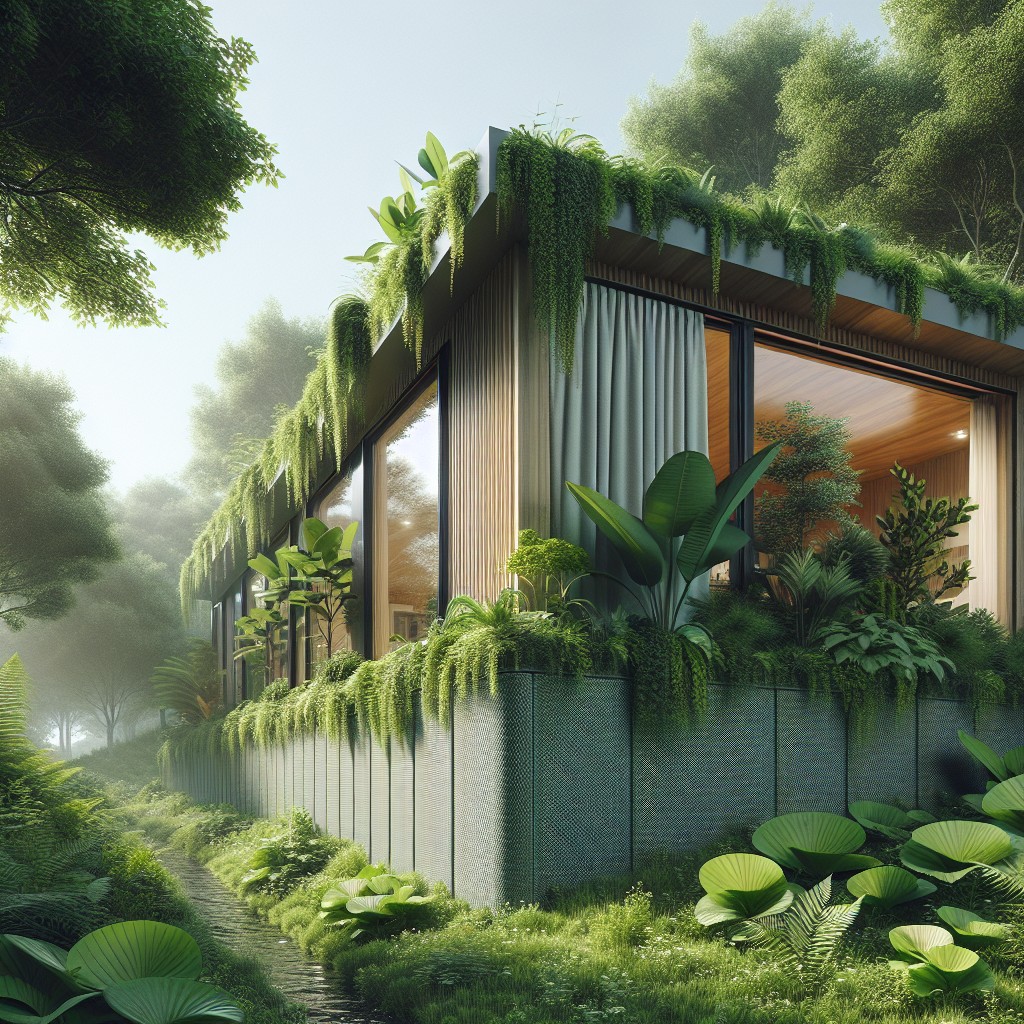
When considering eco-friendly materials for mobile home skirting, it’s important to weigh factors such as sustainability, energy efficiency, and environmental impact. Some of the most conscious choices include:
- Recycled composite boards: They offer durability and require less energy to produce compared to virgin materials, making them a sustainable choice that reduces landfill waste.
- Durable bamboo panels: Known for its rapid regrowth, bamboo provides a renewable skirting option that stands up to the elements and offers a unique, natural aesthetic.
- Cork board: A natural insulator and highly renewable resource, cork board not only enhances energy efficiency but also provides a distinct look and feel.
- Reclaimed wood: Sourcing reclaimed wood for skirting not only gives a second life to existing materials but also adds character to your mobile home with its rustic charm.
- Stone or brick veneer made from recycled content: While offering the appearance of real stone or brick, these veneers use a portion of recycled materials, making them a more eco-conscious choice.
Each option presents its own blend of eco-friendly benefits, contributing to a greener home while helping to conserve resources and minimize carbon footprint.
Skirting for Mobile Homes During Extreme Weather Conditions
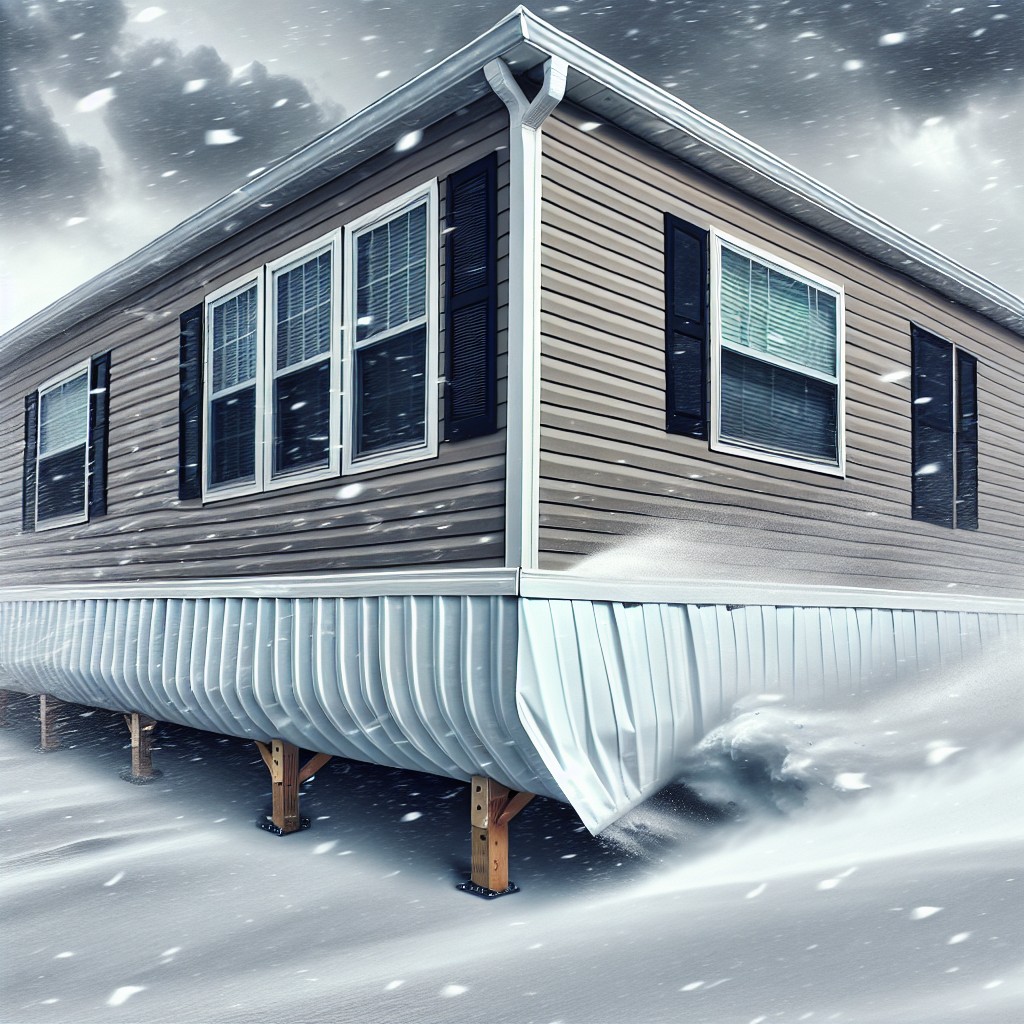
Selecting proper skirting materials is crucial in weathering the storms, literally. In regions prone to harsh weather, metal or concrete skirting can safeguard the mobile home’s underside from damaging winds or flying debris. It’s not only about protection; insulated skirting shields the pipes from freezing in cold climates while promoting a cooler crawl space during heat waves.
Don’t forget ventilation. Despite the need for sturdy materials, air circulation is vital to prevent moisture build-up, which could result in mold or structural damage. Strategically placed vents can offer the necessary airflow without compromising the skirting’s integrity.
Additionally, consider the skirting’s attachment method. In places with high wind risks, secure fastening systems, like ground anchors, are non-negotiable. They ensure skirting remains intact, preventing costly damages or complete system failures.
It’s a balancing act—picking skirting that stands up to local weather conditions while ensuring proper installment and maintenance to prolong its lifespan. Researching region-specific solutions and preparing for extreme weather will keep your home safe and sound year-round.
Incorporating Insulation in Mobile Home Skirting
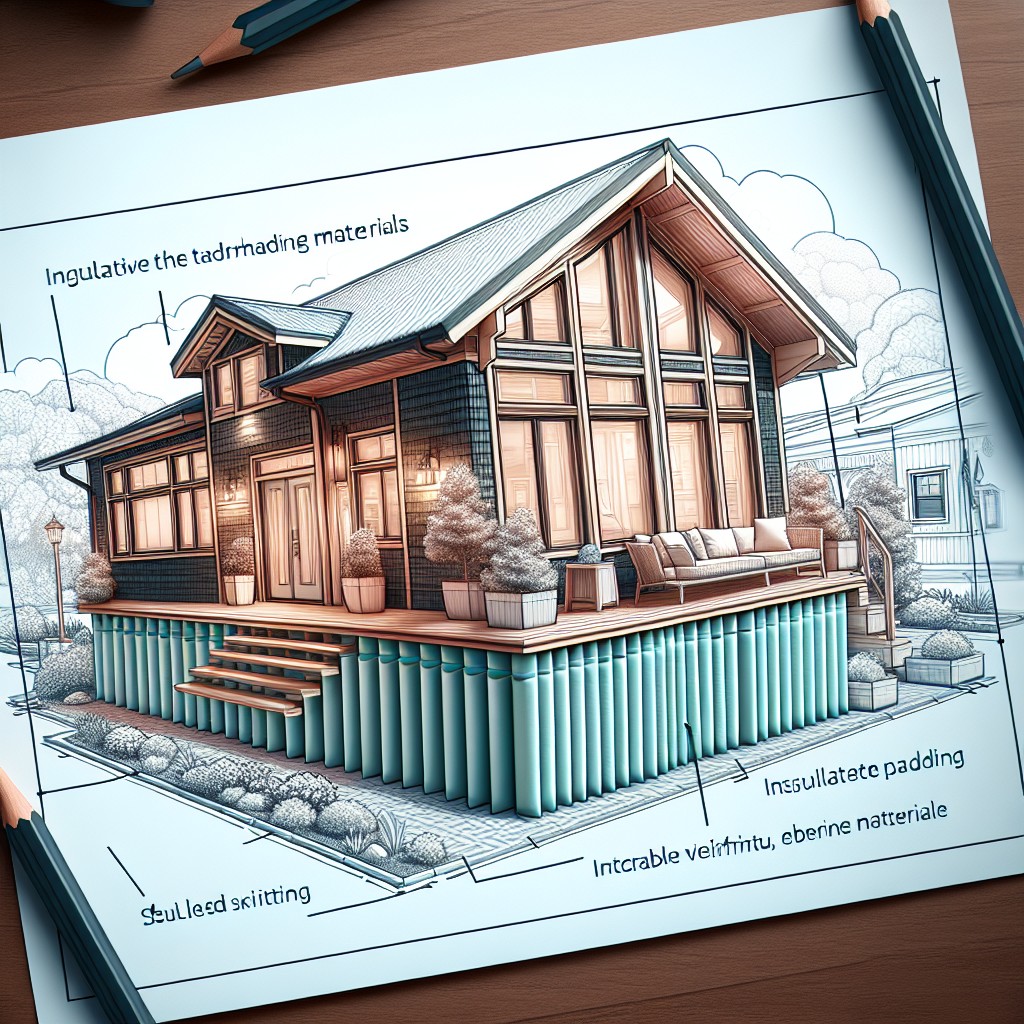
Insulated skirting for a mobile home can be a game-changer, especially in regions with extreme temperatures. This feature acts as a thermal barrier, minimizing heat loss in winter and keeping out excessive heat during summer. The benefit? A more comfortable living space and reduced energy costs.
For efficiency, choose materials with a high R-value, which indicates stronger resistance to heat flow. Common options include foam board or fiberglass batting encased in weather-resistant panels. The installation process may require framing beneath the mobile home to hold the insulation in place.
Besides temperature control, insulation can prevent pipes from freezing and reduce the risk of moisture-related issues, such as mold. Some homeowners even find that insulated skirting deters pests seeking warmth.
Remember to seal any gaps where air could infiltrate to maintain the integrity of the insulation. Regular checks are also vital to ensure the material remains dry and intact, ensuring long-lasting performance.
Trendy Skirting Ideas: From Rustic to Modern Designs

Transforming the base of your mobile home can significantly impact its overall look. Embrace a rustic vibe by choosing natural-looking materials such as stone or faux stone panels that offer a touch of the wilderness. Wood, particularly cedar or redwood, brings warmth and blends seamlessly with natural surroundings.
For a sleek, modern finish, consider using metal skirting like galvanized steel or aluminum. These materials reflect a clean and minimalist style while providing durability. Vinyl skirting, available in numerous colors and textures, allows for personalization that can mirror the style of contemporary homes.
Composite materials offer the best of both worlds—durable and often textured to imitate wood or stone—they’re perfect for homeowners looking for a balance between classic and current trends. The flexibility of composites means design options are almost limitless, ensuring your home stays at the forefront of style while being protected from the elements.
The Role of Skirting in Mobile Home Aesthetics

Skirting can dramatically transform the outward appearance of a mobile home, similar to the effect landscaping has on a house. It bridges the gap between the home and the ground, providing a cohesive look that can elevate curb appeal. Here are some points to consider:
- Harmonizing with the home’s exterior: Choose skirting materials and colors that complement the siding or mobile home’s paint job to ensure a seamless look.
- Enhancing visual appeal: Textured options like faux stone or brick can add a touch of elegance and mimic traditional home foundations.
- Increasing perceived size: Lighter colored skirting can make a home appear larger, while darker tones tend to make it look anchored and solid.
- Reflecting personal style: Skirting provides an opportunity to express individual taste, whether it’s through contemporary vinyl designs or classic wood lattice.
- Subtly concealing utilities: Efficient skirting can hide the less attractive elements such as piers, tie-downs, and utilities while maintaining access points as needed.
Practical Tips On Mobile Home Skirting DIY Installation

When installing mobile home skirting yourself, consider these practical tips to ensure a successful project:
- Preparation is Key: Measure the perimeter of your mobile home carefully, including height variations due to ground level changes. This step is crucial to purchase the correct amount of materials without excess or shortage.
- Choose the Right Materials: Opt for durable and weather-resistant materials such as vinyl, metal, or treated wood that can withstand local climate conditions.
- Ventilation Matters: Install sufficient venting to prevent moisture buildup, which can lead to mold and structural damage. A general rule is to provide 1 square foot of venting for every 150 square feet of floor space.
- Seal Gaps and Joints: Use a sealant where panels meet and along the top and bottom edges to enhance insulation and keep out pests.
- Consult Local Regulations: Check local building codes for requirements specific to mobile home skirting to ensure compliance.
- Use the Proper Tools: A power drill, level, tin snips (for metal), or a saw (for wood) will make the installation process smoother, so have these tools on hand before starting.
- Secure Anchoring: For stability and longevity, securely fasten the skirting to the ground using stakes or a frame attached to the bottom of your mobile home.
By following these practical tips, you’ll be better equipped to undertake a DIY skirting installation that boosts the functionality and appearance of your mobile home.
Identifying the Right Skirting Materials for Different Climates
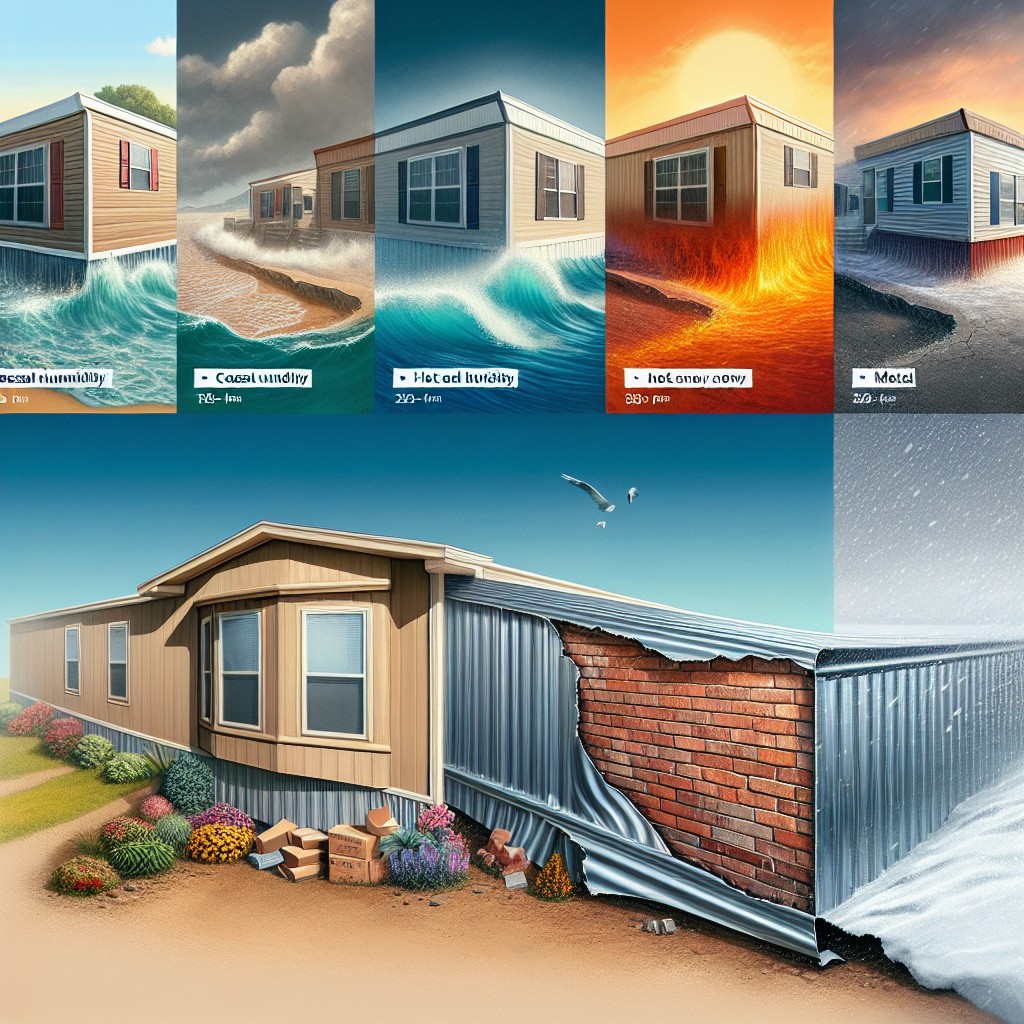
Selecting the appropriate skirting material for your mobile home is contingent on the climate you reside in. Here’s how to align your choice with weather considerations:
- Vinyl Skirting: Ideal for moderate climates, vinyl offers affordability and ease of installation. It provides a basic level of insulation and can withstand temperature variations without extreme stress.
- Metal Skirting: For areas with substantial temperature fluctuations, metal, commonly aluminum or galvanized steel, proves durable. It resists rust and can handle snow load, but may require additional insulation in colder regions.
- Concrete or Brick: In colder environments, these materials provide excellent insulation and sturdiness against the elements. However, they might be costlier and require professional installation.
- Insulated Skirting: A must for harsh winters, insulated panels made from rigid foam or other insulating materials help reduce heat loss, protect pipes from freezing, and save on heating costs.
- Wood Skirting: Aesthetically versatile, wood skirting is suitable for temperate climates but requires treatment for moisture and pest resistance.
- Faux Stone or Brick Panels: These provide a robust barrier against weather and are suitable for various climates based on the construction material. They offer the visual appeal of stone or brick without the weight or cost.
Material quality and proper installation are critical for maximizing the protective benefits of mobile home skirting. Ensure thorough ventilation to prevent moisture buildup, regardless of climate.
The Impact of Skirting On Mobile Home Resale Value

Investing in quality skirting can significantly boost your mobile home’s resale value. Prospective buyers often view skirting as an indicator of overall maintenance and care. Properly installed skirting seals out pests and protects against weather damage, conveying longevity and suggesting less future expenditure for the buyer.
First impressions matter, and skirting can dramatically improve your mobile home’s curb appeal. It offers a finished look that potential buyers find attractive, making the home appear more permanent and akin to traditional real estate.
Moreover, energy efficiency is a selling point. With insulated skirting, you showcase a home that’s geared towards sustainability and cost savings, appealing to energy-conscious consumers. This can translate into a higher selling price.
Keep in mind, the choice of material can also play a role. Durable materials like vinyl or metal may assure buyers of low maintenance, whereas more aesthetic options like faux stone can charm those prioritizing design.
Lastly, uniform and well-fitted skirting suggests meticulous upkeep, giving buyers confidence in the purchase. Thus, skirting not only shields and insulates your home but can serve as a prudent investment to elevate your mobile home’s market appeal and value.
Combining Function and Design With Skirting Choices
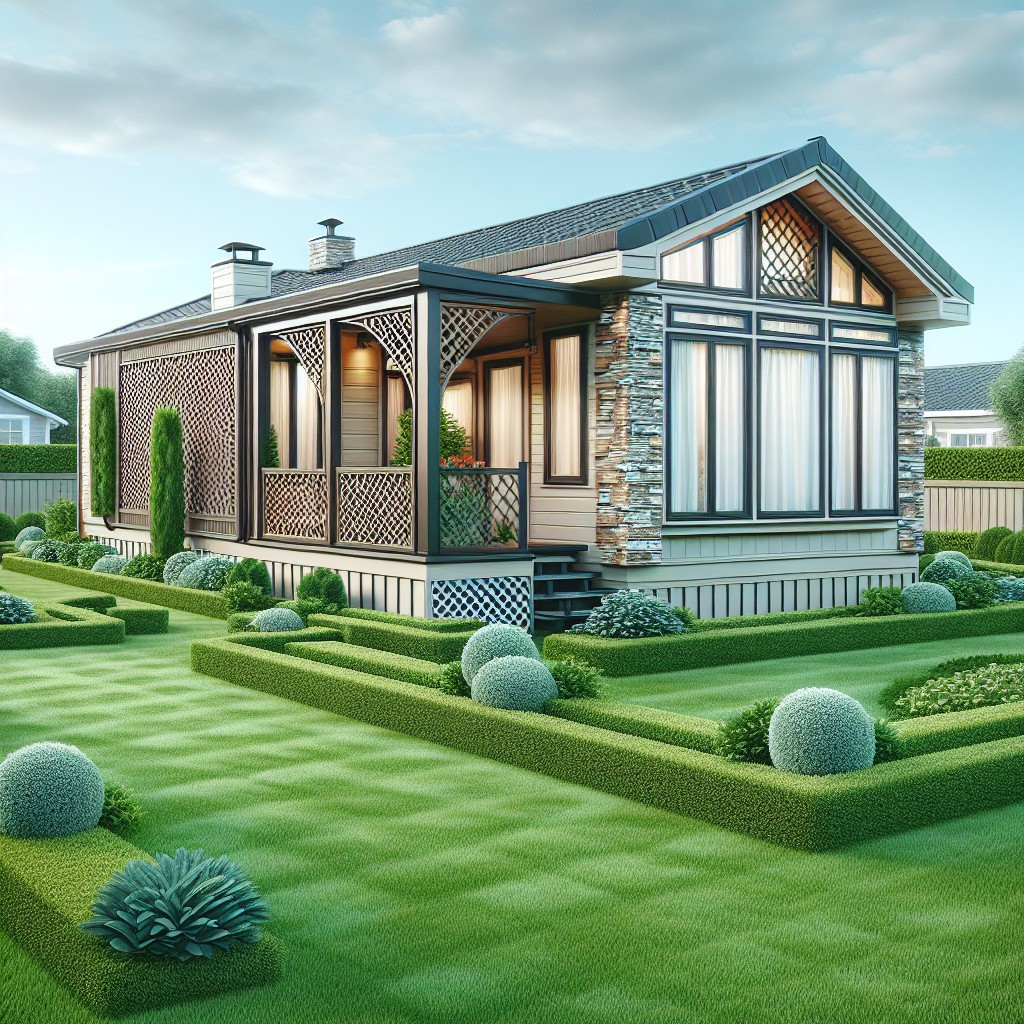
Mobile home skirting serves a dual purpose: it protects the underside of your home from animals and weather elements while enhancing its overall look. With the right choice, you can seamlessly blend these functions.
Vinyl Skirting: Choose from a variety of colors and textures to match your home’s siding, ensuring a cohesive design while enjoying vinyl’s low maintenance and easy installation.
Faux Stone or Brick Panels: These add a touch of elegance and can make a mobile home appear more like a traditional house.
Cement Board: Paintable to any color, cement board is durable and offers a modern, minimalist aesthetic.
Metal Skirting: Ideal for industrial designs, metal offers high durability and can also be painted to fit your desired color scheme.
Lattice Panels: For a more open design that still deters pests, lattice panels provide ventilation and a charming, cottage-style appearance.
Keep in mind the importance of proper ventilation to prevent moisture buildup, which can be elegantly integrated into your design with vent covers that complement your skirting choice.
Mobile Home Skirting: Understanding Durability and Longevity
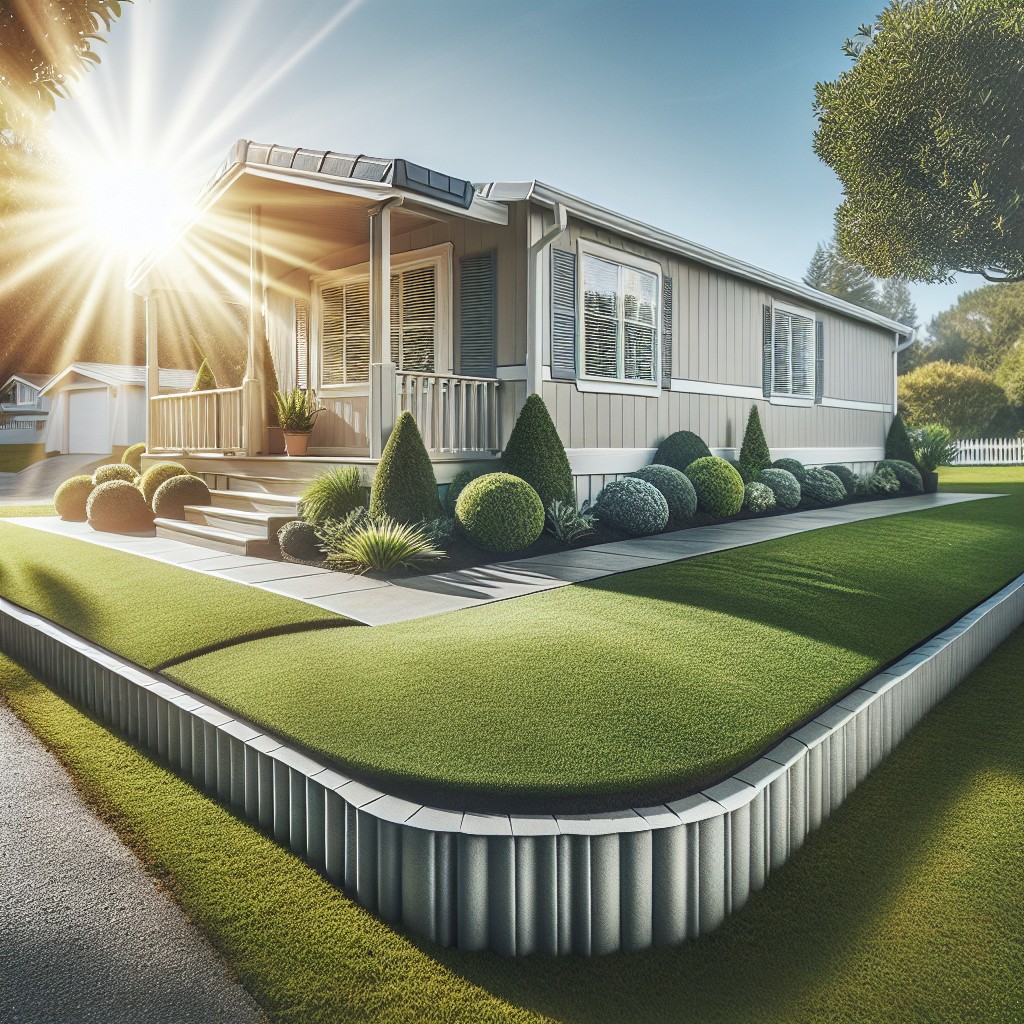
Durability and longevity are central when selecting skirting for your mobile home. These two factors vary greatly depending on material and environmental stressors.
Metal skirting, such as steel or aluminum, withstands physical impacts and adverse weather. However, it can be prone to rust if not properly coated or maintained.
Vinyl, a popular choice, offers flexibility and resistance to decay, but can become brittle and crack in extreme temperatures.
PVC skirting represents a middle ground, offering decent durability with less susceptibility to weather-induced damage.
Pressure-treated wood skirting adds a natural look and is robust, but requires regular maintenance to fend off rot and pests.
Composite materials, blending wood and plastic, give the appearance of wood without as much upkeep.
Concrete or brick skirting provide the ultimate in longevity but come with increased installation complexity and cost.
To ensure the chosen skirting stands the test of time, consider the local climate and potential stressors like high winds, heavy snow, or persistent humidity.
Additionally, proper installation and periodic maintenance can significantly prolong the life of mobile home skirting, safeguarding the investment and keeping the aesthetic appeal intact.
Customizable Mobile Home Skirting Options
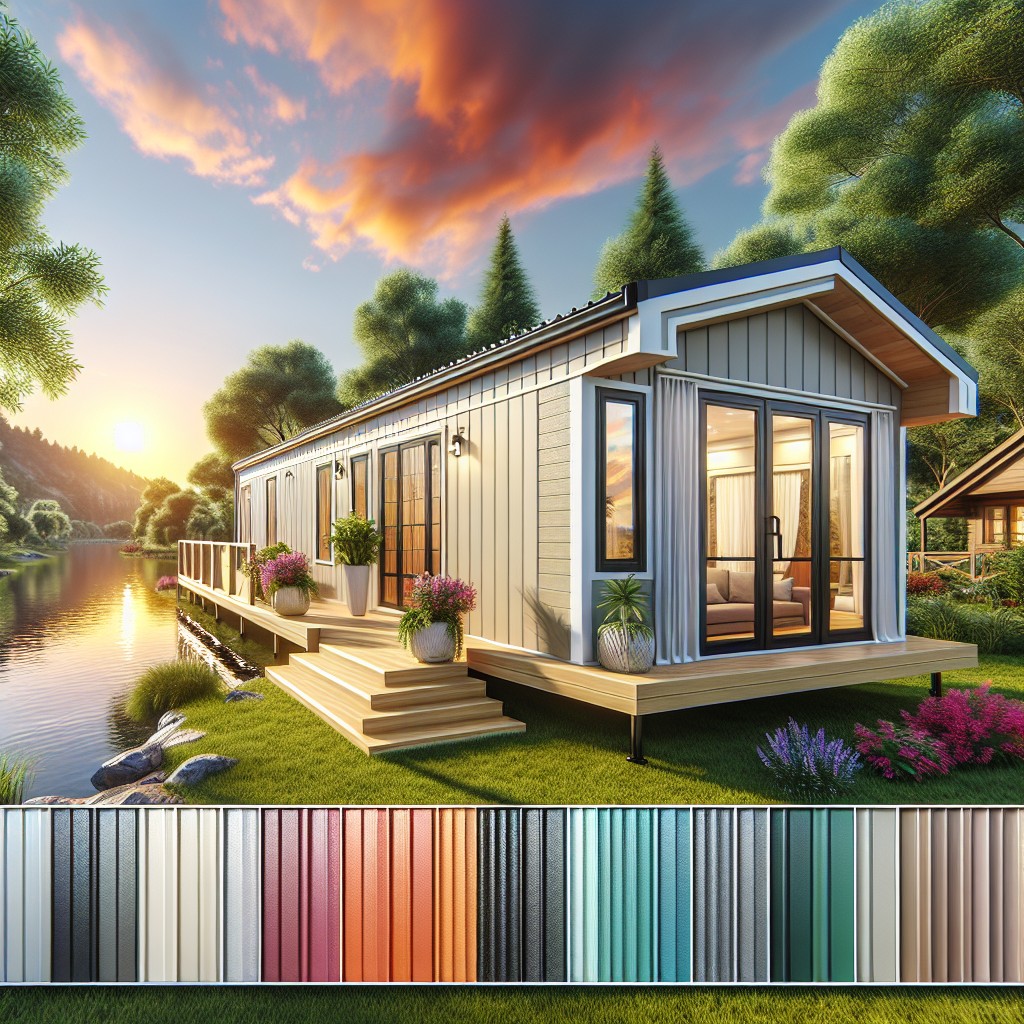
Personalization meets functionality with a range of customizable skirting options that allow homeowners to match their mobile home’s aesthetics while ensuring structural protection:
- Vinyl Skirting with Customizable Panels: Vinyl is not only affordable but also versatile. Panels can be ordered in various colors and textures to complement your home’s exterior.
- Composite Board with Trim Choices: If you prefer a wood-like appearance without the maintenance, composite boards can be cut to size and paired with different trims for a unique finish.
Stucco Finish for Unique Texture: Applying a stucco finish to a durable backing can be colored to suit your preference, offering a Mediterranean feel that’s both stylish and sturdy.
Brick and Stone Veneers: For a classic look, faux brick or stone veneers give the solid appeal of masonry work and can be chosen to blend with the environment or stand out as a feature.
Metal Skirting with Decorative Cutouts: Metal skirting can be customized with cutouts – think lattice patterns or personalized designs – that provide ventilation and add a decorative touch.
Insulated Skirting with Custom Panels: Energy-efficient insulated skirting can be ordered in various sizes and finishes, keeping the under-home area temperate and reducing heating costs.
These options can be mixed and matched or altered in dimension to create a skirting solution that is as unique as the home above it, providing an equal balance of individual expression and practical application.
The Effectiveness of Skirting for Pest Control
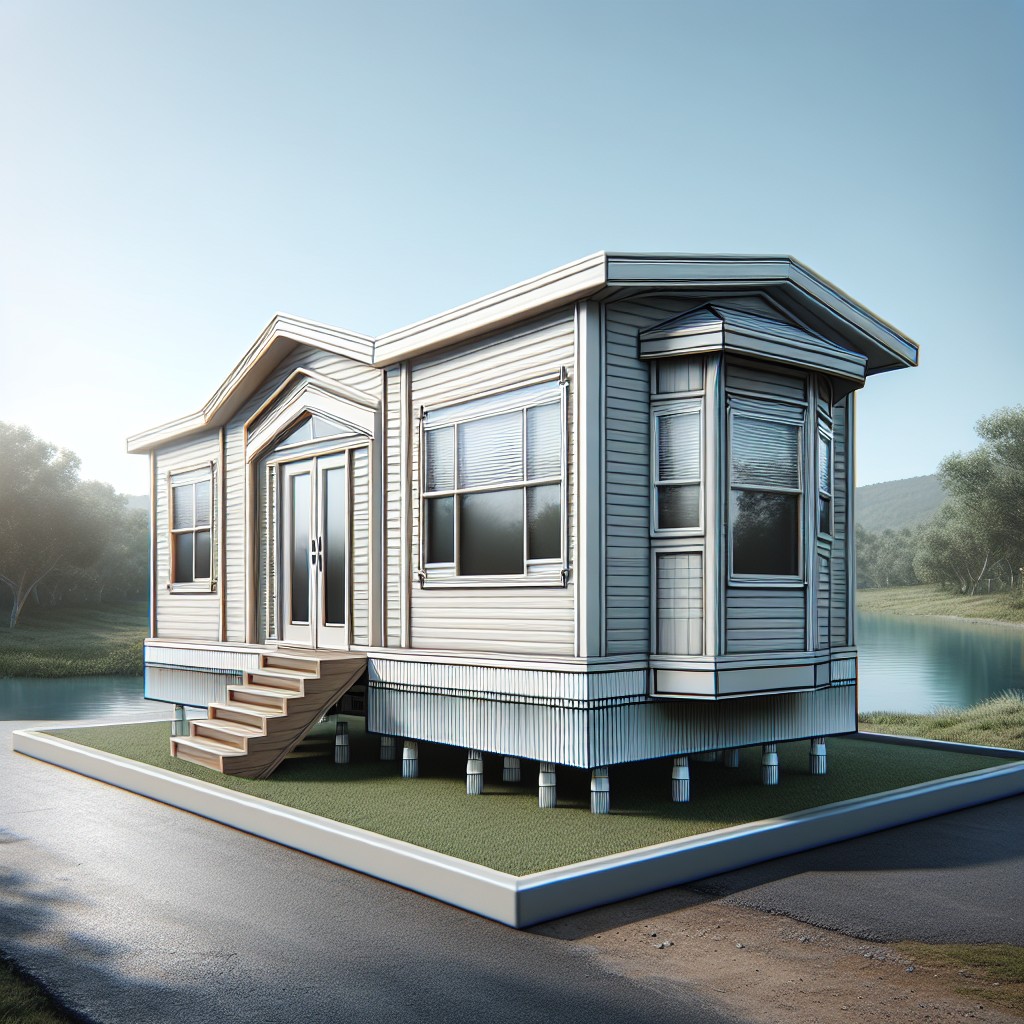
Skirting serves as a first line of defense against unwelcome critters by sealing off the gap between the ground and the bottom of your home. Here are key points demonstrating the role of skirting in pest control:
- Acts as a Barrier: Properly installed skirting creates a physical blockade that deters rodents, insects, and other pests from accessing the underbelly of your home, where they could cause damage or create nests.
- Ventilation is Key: While it’s important to have a solid barrier, adequate ventilation prevents moisture buildup, which can attract pests. Ensure your skirting has venting provisions to maintain a dry environment under the home.
- Material Matters: Durable materials like metal or vinyl are less susceptible to being breached by pests compared to softer materials like plywood which can be gnawed through.
- Access Points: Regular inspection of your skirting for cracks, holes, or gaps is crucial in preventing pests from finding a way in. Promptly sealing any openings will reinforce your mobile home’s protection.
- Combining Efforts: For a comprehensive approach, consider adding pest control measures such as insect screens or pesticide treatments to the perimeter where the skirting makes contact with the ground.
Remember, effective pest control starts with a secure and well-maintained skirting system. Regular checks and timely repair or upgrade can save you from the hassle and expense of pest invasions.
Breakdown On Costs: Comparing the Most Common Skirting Materials
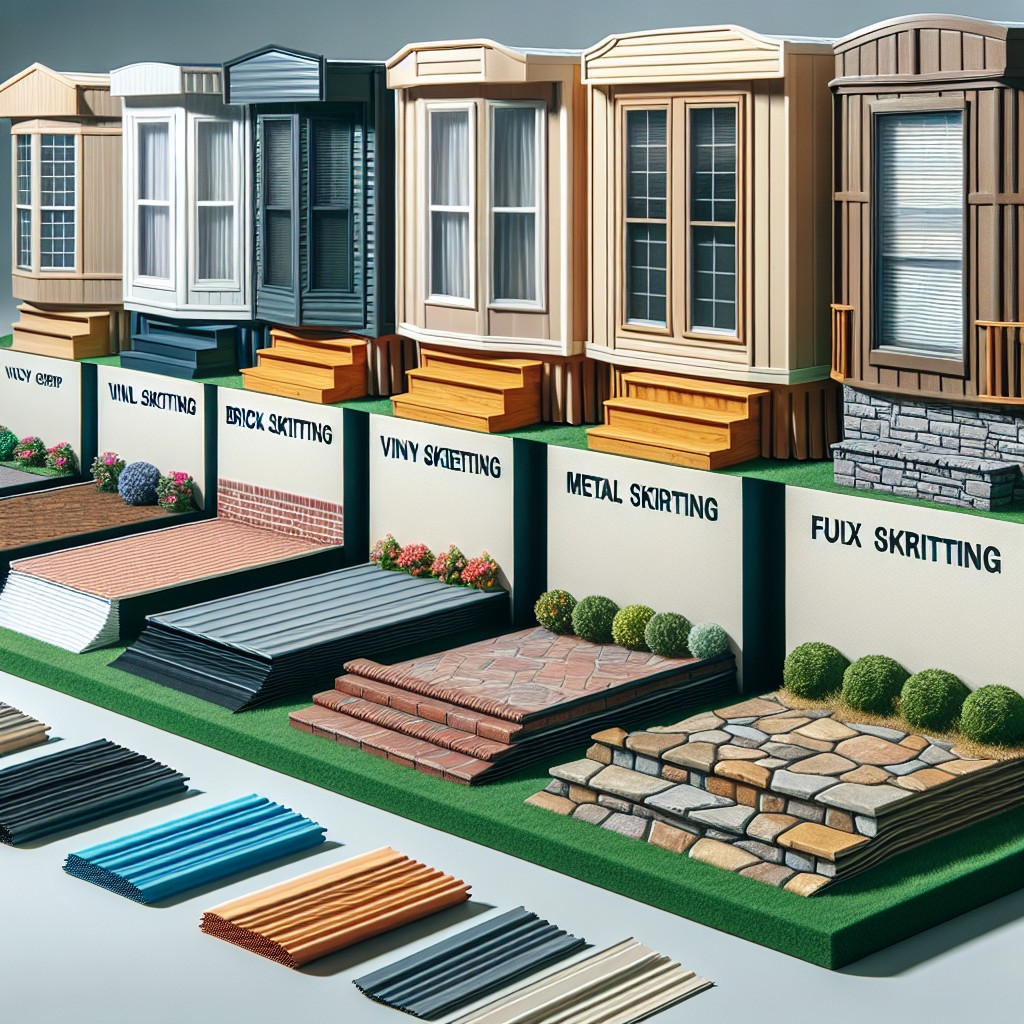
When evaluating skirting materials, cost is a pivotal factor:
- Vinyl is the most economical choice, widely available and easy to install. It offers a variety of design options but might require more frequent replacement.
- Metal skirting, typically aluminum or steel, is more durable than vinyl and moderately priced. It’s sturdy against weather elements but can be prone to denting and rust if not properly maintained.
- Treated wood provides a classic look and can be painted or stained to match your home. It’s costlier than vinyl but offers better insulation.
- Concrete or brick is at the higher end of the price spectrum, offering unmatched durability and insulation. Although the upfront cost is substantial, it’s a long-term investment due to minimal maintenance needs.
- Insulated skirting materials such as foam boards are more expensive initially but can save money in the long run by reducing energy bills.
Remember, installation costs should also be factored into the overall budget, as some materials may require professional help. Always consider both the material and labor costs when planning your mobile home skirting project.
The Role of Skirting in Mobile Home Energy-Efficiency
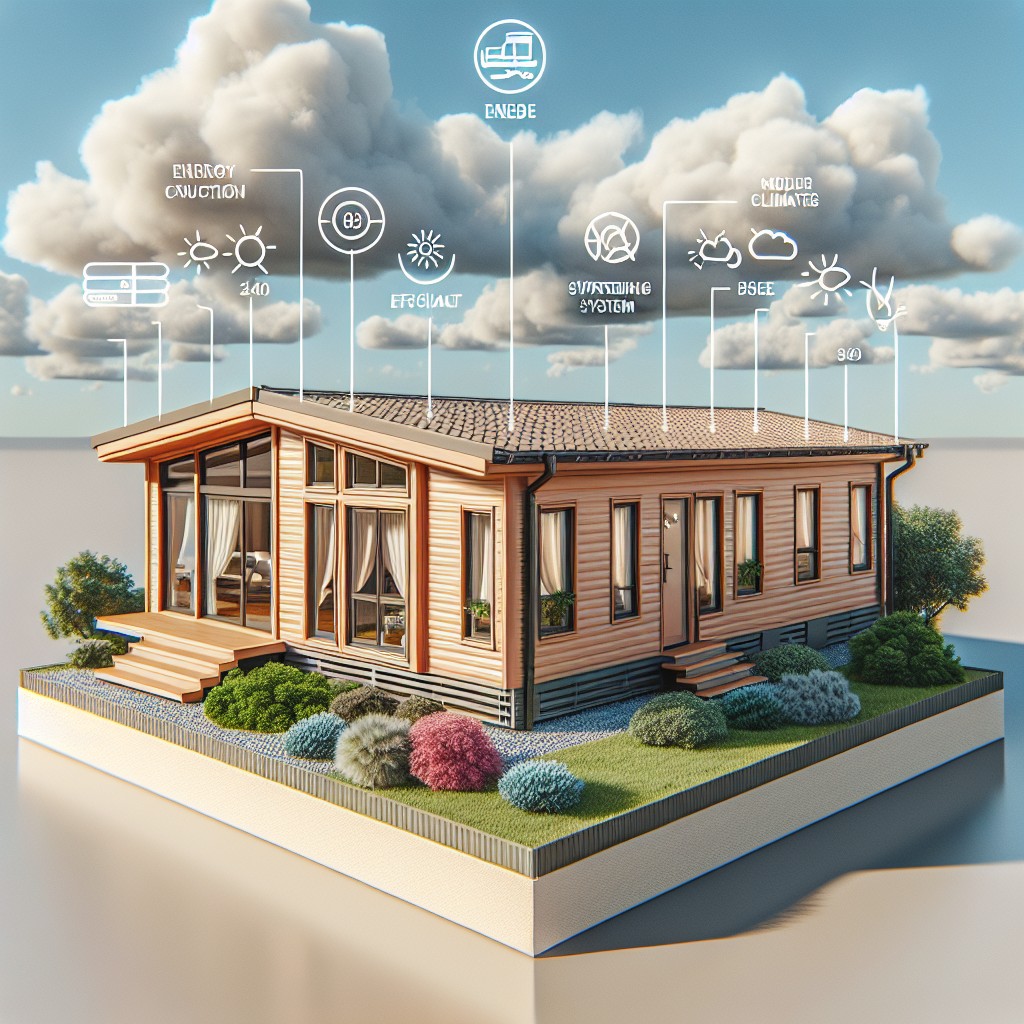
Skirting acts as a barrier between the underside of your mobile home and the outside environment, playing a critical role in maintaining energy efficiency. Here’s how:
1. Insulation Effect: It helps keep heat in during the colder months and cool air in during the warmer months, reducing the need for excessive heating or air conditioning.
2. Reduced Air Infiltration: By sealing the gap under the home, it minimizes the drafts that can come through the floor, leading to a more stable indoor temperature.
3. Protection Against Elements: Skirting guards against water, snow, and ice, which can erode the integrity of your home’s structure and insulation if left unchecked.
4. Optimization of HVAC Performance: With a more constant internal temperature, HVAC systems work more efficiently, lowering energy consumption and costs.
5. Moisture Control: It helps prevent moisture build-up which can lead to mold growth and rot, both of which can damage insulation and decrease energy efficiency.
By investing in the right skirting, you’re not only enhancing your home’s aesthetic but also contributing to a significant improvement in its energy-saving capabilities.
How to Properly Clean and Maintain Your Mobile Home Skirting

Keeping your skirting in top condition extends its lifespan and preserves the appearance of your mobile home. Start by regularly inspecting for signs of wear or damage, such as cracks or holes that can allow pests in or lead to heat loss.
Cleaning is straightforward. For vinyl and metal skirting, use a gentle soap and water mixture applied with a soft cloth or a non-abrasive brush to remove dirt and debris. Rinse with a hose on a low-pressure setting to avoid water damage or denting. For wooden skirting, a mild wood cleaner works best to maintain the finish without causing warping or discoloration.
It’s also important to trim any nearby vegetation to prevent moisture buildup and decay. Ensure proper ventilation is maintained to avoid mold growth which can deteriorate skirting materials. If you find any minor damages, repair them promptly. Seal small openings with appropriate caulking, replace damaged panels as necessary, and, for brick or concrete, fill in cracks with mortar.
Schedule these maintenance tasks seasonally to adapt to changing weather conditions and address any issues that arise from temperature fluctuations. Regular care keeps your mobile home skirting both functional and visually appealing.
Skirting Solutions for Unleveled Mobile Homes
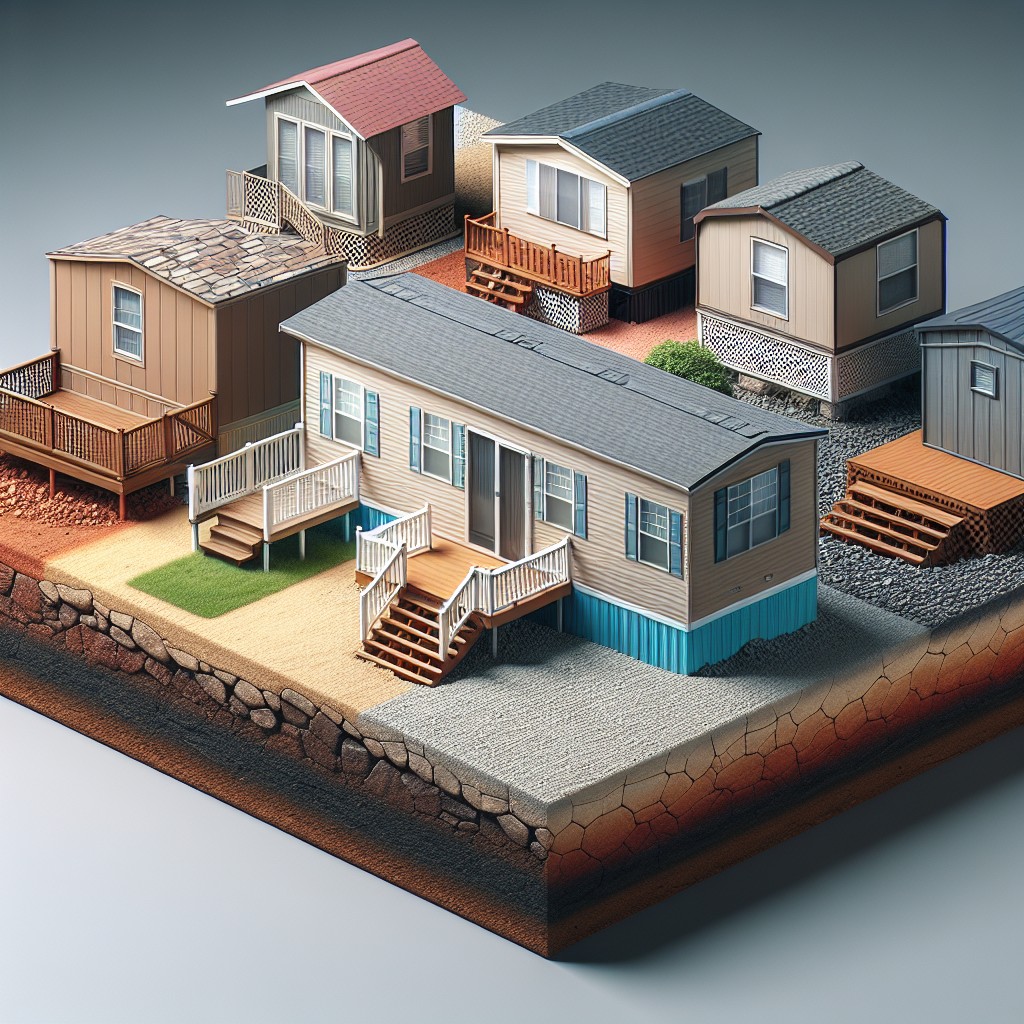
Addressing uneven terrain requires flexibility in skirting application. It’s essential to ensure stability and a snug fit around the perimeter, regardless of ground inconsistencies.
Here are some strategies:
- Use adjustable skirting panels: These can be extended or retracted to fill gaps created by an irregular ground surface, ensuring a tight fit.
- Implement a stepped foundation approach: Skirt sections follow the contour of the terrain, stepping down or up to accommodate slopes.
- Custom-cut panels: Tailor each piece to match the precise height needed for various areas around the home.
- Incorporating a base track system: It anchors the skirting, allowing for variations in height while keeping the installation secure.
- Add landscaping features: Use retaining walls or graded soil to even out the ground before adding skirting, for a more traditional application.
These solutions not only provide the necessary coverage and insulation but also contribute to a visually pleasing finish that complements the mobile home structure, regardless of the uneven terrain.
Comparing Professional Vs. DIY Skirting Installation
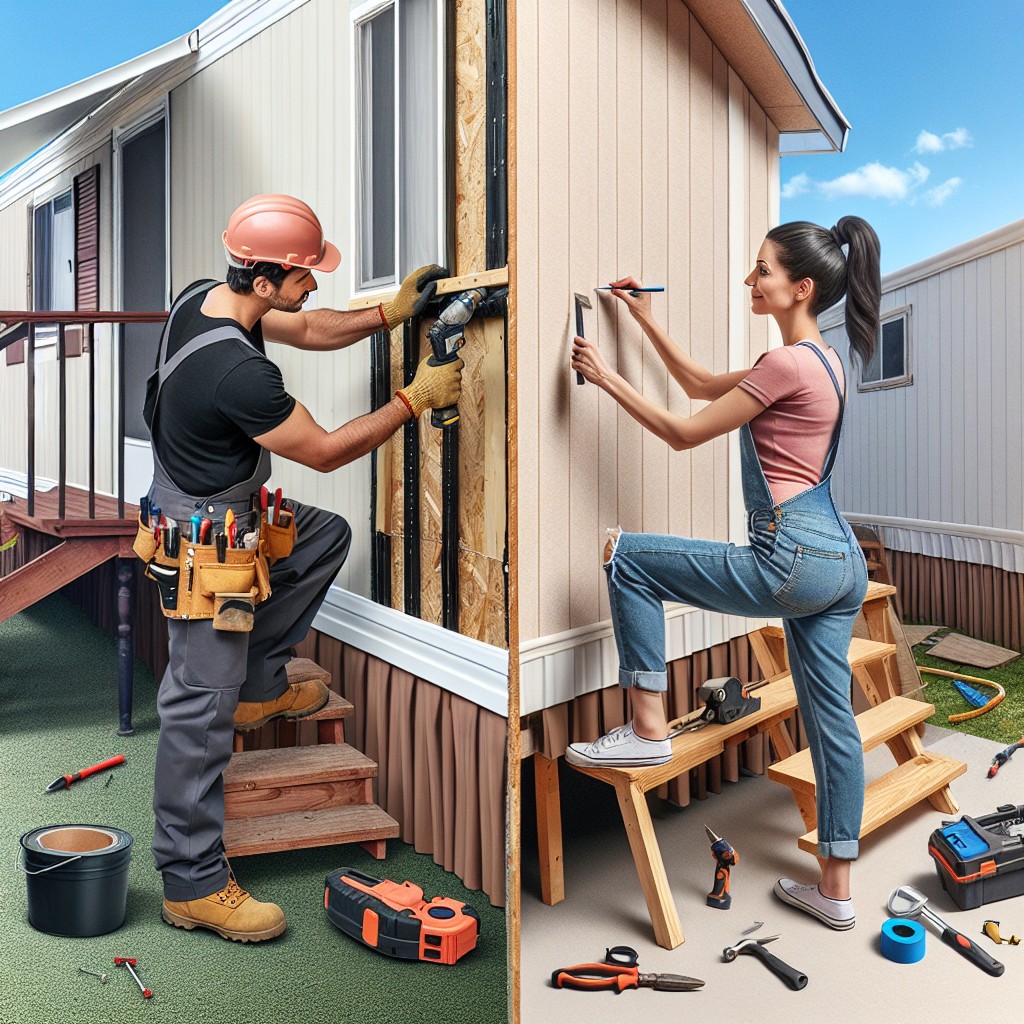
When weighing the options of professional installation versus undertaking the task yourself, consider several factors to make an informed decision.
Expertise and Quality Assurance: Professionals bring a wealth of experience, ensuring a high-quality finish that adheres to the latest building codes and manufacturer recommendations. They can foresee issues and provide solutions that might not be apparent to the average DIYer.
Time Investment: DIY projects can be time-consuming, especially if you lack prior experience. Professional installation is typically quicker, allowing you to enjoy a finished look without the personal investment of time and labor.
Tools and Equipment: Professionals come equipped with all the necessary tools, which may be specialized and not commonly found in a typical homeowner’s toolbox. If you choose to do it yourself, factor in the cost and availability of these tools.
Cost Efficiency: While hiring a professional involves labor costs, DIY requires purchasing materials and potentially the tools to carry out the job. Mistakes can be costly, requiring additional materials or even a professional to correct them, negating any initial savings.
Warranty and Liability: Professional services often come with a warranty for the work performed, providing peace of mind. DIY installations may void warranties on materials if not installed correctly, and any damages incurred during installation are your responsibility.
Consider your skill level, the complexity of the job, and the potential long-term implications of each approach before deciding on the best route for your mobile home skirting installation.
How to Pick the Best Skirting for Older Mobile Homes
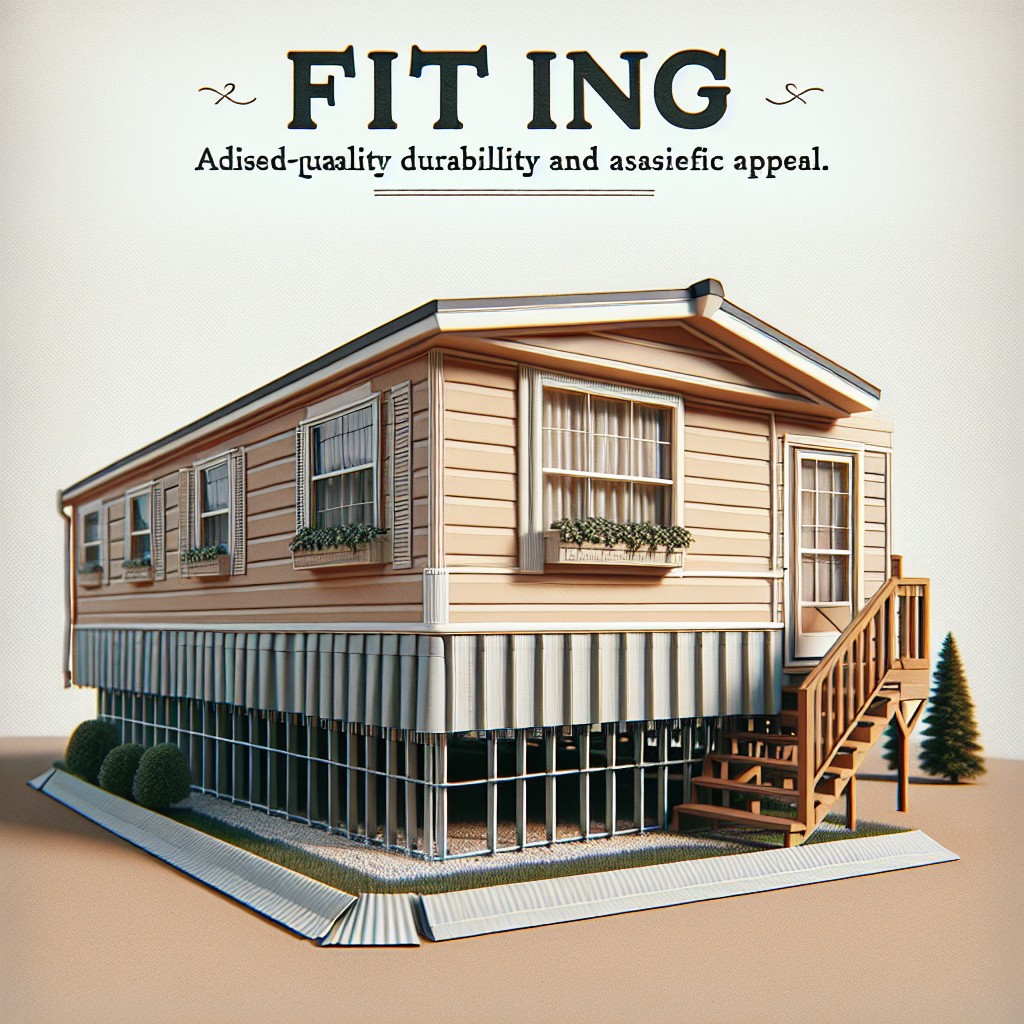
Selecting suitable skirting for an older mobile home involves careful consideration of several factors:
- Assess the existing structure: Check the mobile home’s condition, especially the bottom rim where the skirting will attach. Ensure that the area is stable and capable of supporting new skirting material.
- Historical climate impact: Take into account the weather patterns your home has endured. Look for materials that can withstand local climate extremes and have a proven track record for durability.
- Aesthetics integration: Choose skirting that complements the era of your home. Vintage mobile homes can benefit from classic materials like brick or stone, adding character while providing protection.
- Ventilation: Ensure that the material and design selected allow for adequate ventilation to prevent moisture buildup, which can cause structural damage and mold growth.
- Installation challenges: Some skirting materials require more involved installation methods. Weigh the ease of installation against long-term benefits, especially if you’re considering a DIY approach.
- Insulation benefits: Consider the thermal properties of skirting options. Insulated skirting can help maintain a consistent indoor temperature, reducing energy consumption.
- Local regulations: Check local codes and regulations regarding skirting materials and installation as they can vary by location and may influence your choices.
By factoring in these points, you can make an informed decision for your older mobile home’s skirting that enhances its longevity, aesthetic appeal, and overall functionality.
Creative Ways to Decorate and Enhance Skirting for Holidays
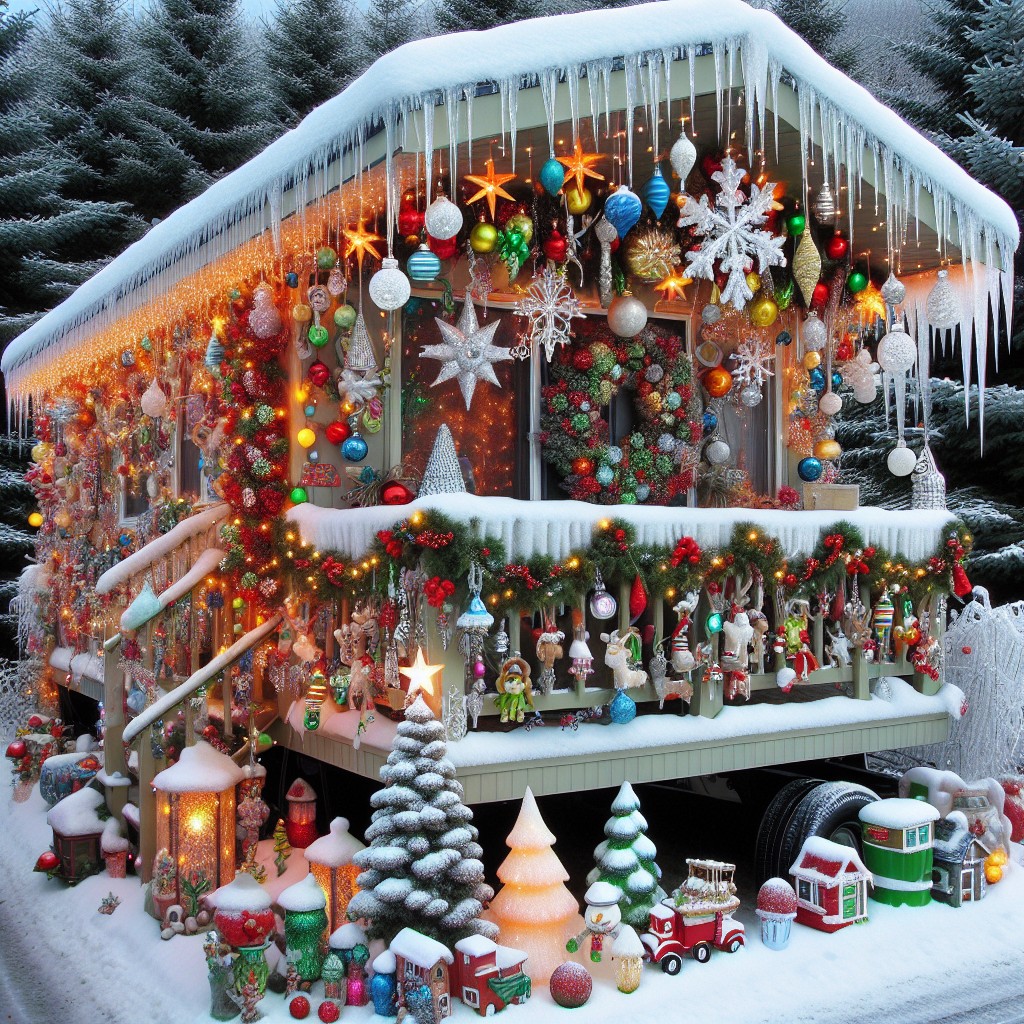
Embrace seasonal cheer by adding festive touches to your mobile home’s foundation. String lights offer an instant holiday glow, draped along the top edge or woven through lattice skirting. Weather-resistant ribbons and garlands can be interlaced through vented skirting for a pop of color and texture.
Consider attachable decorations like festive wreaths or lightweight ornaments that can be hooked onto skirting without causing damage. Reflective decals in shapes like snowflakes or stars can create a shimmering effect without permanent alterations. Temporary chalkboard or magnetic paint allows for custom, changeable messages and drawings that can celebrate any holiday.
For a creative twist, silhouette light panels cut into holiday-themed shapes can backlight your skirting, creating an attention-grabbing night display. Always ensure decorations are safely secured and compatible with your skirting material to prevent damage.
Pros and Cons Analysis of Popular Skirting Options
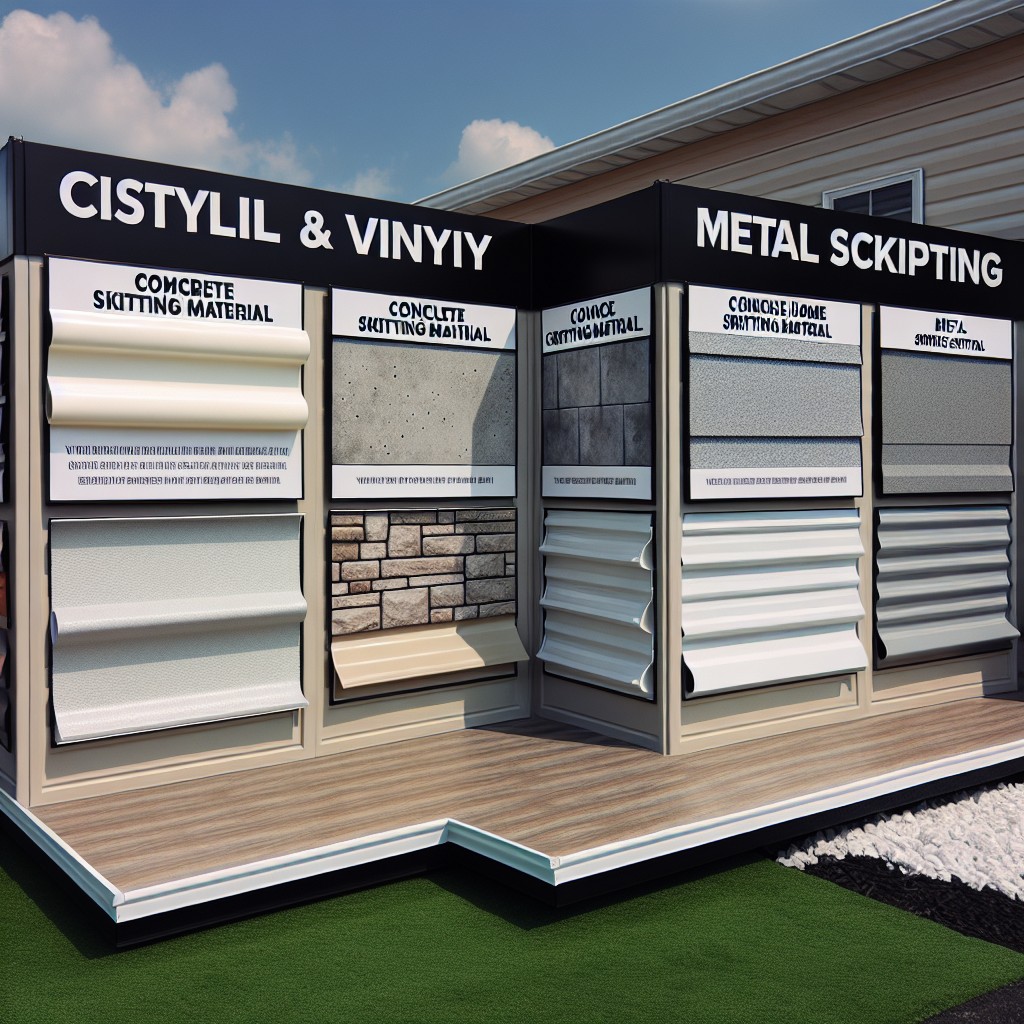
Vinyl skirting is affordable and easy to install, making it a go-to choice for many homeowners. It comes in a variety of colors and patterns, offering flexibility in design. However, vinyl can become brittle in extreme cold and may not withstand impacts well.
Metal options, such as steel or aluminum, are sturdier and more resistant to adverse weather. They provide a sleek look and are fire-resistant. On the flip side, they can be prone to rust if not properly treated or maintained, and usually come at a higher price point.
Cement board skirting presents an excellent blend of durability and aesthetics. It can mimic the appearance of stone or brick and is resistant to fire, pests, and rot. While it excels in longevity, it’s heavier than other materials and requires a more labor-intensive installation process.
Wood lattice skirting offers a classic and natural look that’s easily customizable. It’s relatively inexpensive and can be painted or stained to match your home. Yet, it requires regular maintenance to prevent rot and insect infestation and may not be the best insulator.
Faux stone or brick panels provide the elegance of masonry without the weight and cost. These panels are easy to install and offer good insulation. However, they may fade over time, and high-quality options can be on the pricier end.
Each skirting material comes with its set of advantages and considerations. Prioritize your needs—whether it’s budget, durability, maintenance, or aesthetics—to guide your decision-making process.
Ideas Elsewhere
- https://www.homedit.com/mobile-home-skirting/
- https://architecturesstyle.com/mobile-home-skirting/
- https://www.reddit.com/r/homeowners/comments/p2xsqn/siding_and_skirting_options_to_make_my_mobile/
- https://duraskirt.com/blog-alternatives-to-mobile-home-skirting/
- https://homenation.com/blog/mobile-home-skirting-tips-and-basics
- https://www.findmymobilehome.com/blog/types-of-mobile-home-skirting
Table of Contents




